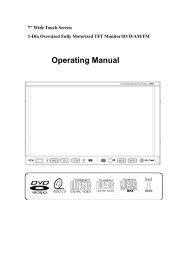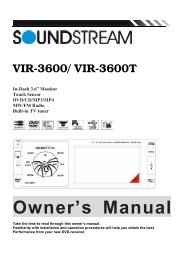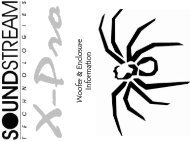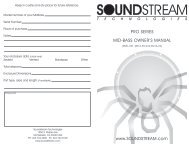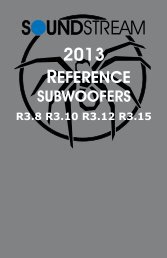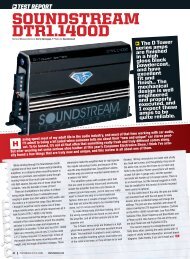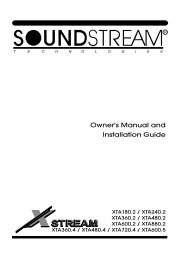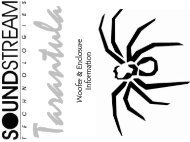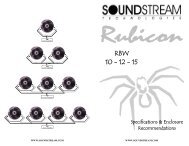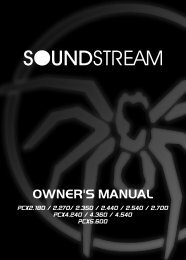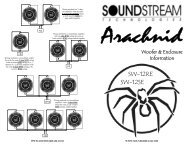REFERENCE 500s 700s 1000s - Soundstream
REFERENCE 500s 700s 1000s - Soundstream
REFERENCE 500s 700s 1000s - Soundstream
Create successful ePaper yourself
Turn your PDF publications into a flip-book with our unique Google optimized e-Paper software.
LSE.Q THEORY AND USE (Reference<strong>1000s</strong>)<br />
FIG. 1 LSE.Q<br />
LSE.Q is a unique subwoofer control circuit<br />
included with the SOUNDSTREAM<br />
<strong>REFERENCE</strong><strong>1000s</strong> amplifier. It is capable of<br />
removing subsonic energy in program material.<br />
The circuit consists of two controls. One adjusts<br />
the frequency of operation and the other adjusts<br />
the range of boost. With both controls adjusted<br />
fully counter-clockwise, no boost is applied and<br />
the amplifier is flat in response down to 30 Hz.<br />
The frequency control (Hz) adjusts the starting point of the subsonic<br />
filter. This high pass filter can be adjusted from 30 Hz up to a<br />
maximum of 60 Hz. This control<br />
is useful for setting the lowest<br />
frequency that your subwoofer will<br />
10<br />
5<br />
0<br />
Q=2.8<br />
-5<br />
see. (See figure 1)<br />
dB<br />
The Q control adjusts the<br />
amount of boost applied at the set<br />
frequency. This is adjustable<br />
from .707 (flat) to 2.8 (+9 dB).<br />
(See figure 2)<br />
When the Q is set to .707<br />
(Butterworth), LSE.Q acts as a<br />
sub-sonic filter only. (See figure<br />
3)<br />
-5<br />
dB<br />
-10<br />
The simple act of removing the -20<br />
signal below the vented tuning<br />
-25<br />
-30<br />
frequency can improve system 10<br />
output by as much as 3 dB. With<br />
Q values greater than .707, boost<br />
is added to the sub-sonic filter. (see figure 4)<br />
10<br />
5<br />
0<br />
-5<br />
dB<br />
-10<br />
-15<br />
-20<br />
-25<br />
-30 10<br />
Frequency (Hz)<br />
FIG. 4 Variable “Q”<br />
50 100 200<br />
14<br />
-10<br />
-15<br />
-20<br />
-25<br />
-30 10<br />
10<br />
5<br />
0<br />
-15<br />
Frequency (Hz)<br />
FIG. 2 Variable “Q”<br />
Frequency (Hz)<br />
Q=0.707<br />
50 100 200<br />
50 100 200<br />
FIG. 3 Variable High Pass<br />
Application<br />
Woofers in vented enclosures have<br />
good power handling characteristics<br />
above the tuning frequency, but<br />
below the tuning frequency, power<br />
handling drops off considerably.<br />
This is due to the loss of any<br />
appreciable resistive air mass. At<br />
Key to Callouts<br />
1. Fault LED - Indicates a blown fuse.<br />
2. High Power LED - Indicates amplifier power on in "High Power" mode.<br />
3. Auto High Current LED - Indicates amplifier power on in "High Current"<br />
mode.<br />
4. Line Out Crossover Switch - Select high pass, low pass or full range low<br />
level output to an auxiliary amplifier.<br />
5. LSE.Q Bypass Switch - Turns the LSE.Q on ("IN") or off ("OUT").<br />
6. Input Overload Indicators - Indicates the signal input level or input gain<br />
level is too high.<br />
7. Input Level Selector Switch - Selectable input sensitivity range from 0.2-<br />
2 Volts RMS, or from 0.5-5 Volts RMS.<br />
8. Left Channel Balanced / Unbalanced Input Selector Switch - Select<br />
"Balanced" to use the 6 pin Balanced signal input. Select "Unbalanced" to<br />
use the RCA signal inputs.<br />
9. Right Channel Balanced / Unbalanced Input Selector Switch - Select<br />
"Balanced" to use the 6 pin Balanced signal input. Select "Unbalanced" to<br />
use the RCA signal inputs.<br />
10. Main Fuse - Main power supply fuse. Replace only with the same value<br />
fuse.<br />
11. +12V - Connected to a fuse or circuit breaker, then to the battery's positive<br />
post.<br />
12. GND - Main ground connection. Bolt to a clean chassis ground in the<br />
vehicle.<br />
13. REM - Remote turn-on input from the head unit. Accepts +12V.<br />
14. Speaker Output Connections - Left and right channels.<br />
15. Crossover Output - High pass, low pass or full range output to an<br />
auxiliary amplifier.<br />
16. Crossover Adjustment Pots - Crossover frequency settings for high<br />
pass and low pass filters; Amplifier and crossover outputs.<br />
17. LSE.Q - Frequency and Q adjustments.<br />
18. Input Level - Independent Left and Right channel input level controls.<br />
19. Balanced Signal Input Connector - 6-pin Balanced signal input<br />
connector for use with the <strong>Soundstream</strong> BLT Balanced Line Transmitter.<br />
20. Inputs - Right and left channel RCA (Unbalanced ) inputs; only right<br />
channel input is used in "Mono" mode.<br />
21. Coherent Stereo/Bridge/Mixed Mono switch - Select "Bridge" for<br />
bridged mono operation (use right channel input). Select "Stereo" for<br />
coherent stereo operation. Select "Mixed Mono" for simultaneous stereo /<br />
bridged mono operation.<br />
22. Amplifier Crossover - Select high pass, low pass or full range amplifier<br />
operation.<br />
11




